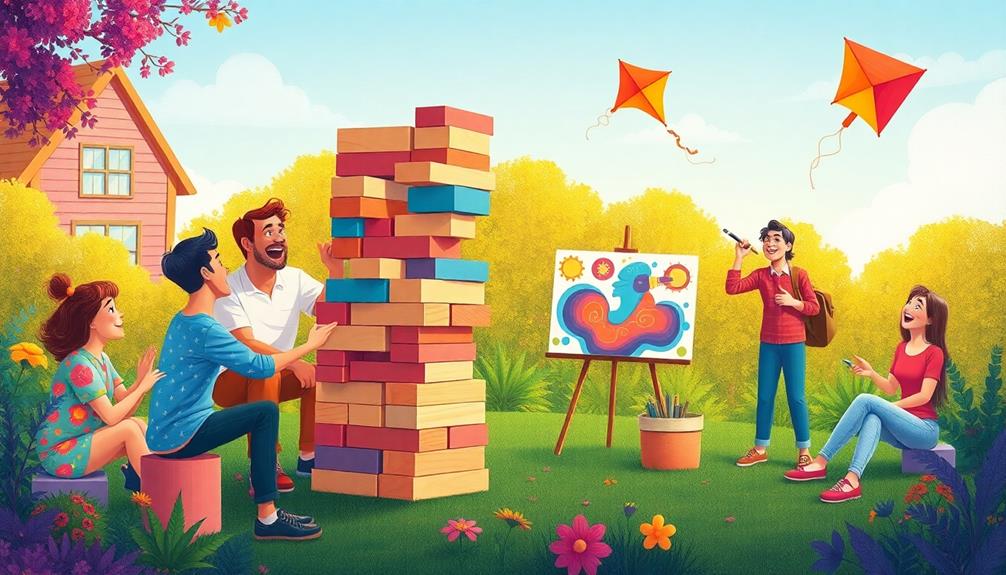Embracing your inner child through playfulness can greatly enhance your adult life. Engaging in playful activities helps reduce stress and boosts happiness, making life more fulfilling. You'll notice improved relationships and a more creative mindset. It's crucial to overcome barriers like busy schedules or fears of judgment that limit your playtime. By incorporating fun activities—like game nights, arts and crafts, or outdoor adventures—you can reignite your curiosity and joy. So, why not explore how incorporating play into your daily life can lead to even greater benefits? There's so much more to discover about playfulness!
Key Takeaways
- Embracing play reduces stress and anxiety, significantly enhancing mental health and emotional well-being in adults.
- Engaging in playful activities fosters creativity, cognitive flexibility, and innovative problem-solving skills.
- Shared playful experiences strengthen social connections, deepen relationships, and create lasting memories.
- Prioritizing play in adulthood can boost happiness and life satisfaction by approximately 20%.
- Incorporating play in professional environments enhances productivity, collaboration, and overall employee satisfaction.
The Role of Play in Adulthood

Embracing playfulness as an adult can greatly enhance your life. When you engage in playful activities, you considerably reduce stress and anxiety levels, leading to better mental health. This isn't just about feeling good; it's about enhancing your cognitive flexibility and creativity, which are essential for effective problem-solving in both your personal and professional life.
Additionally, incorporating elements of visualization techniques can help you manifest a more playful mindset.
Incorporating play into your routine can elevate your happiness and life satisfaction. Adults who actively participate in playful activities often report a more fulfilling emotional state. These experiences not only boost your mood but also strengthen social connections. Shared moments of play create lasting memories, enhancing your relationships and building community bonds.
Moreover, playful environments can increase workplace productivity by as much as 20%. This means that allowing yourself to embrace play at work can lead to more innovative ideas and efficient teamwork.
Rediscovering Joy Through Play

Rediscovering joy through play can transform your daily life, sparking curiosity and a sense of freedom. Engaging in playful activities not only boosts your mental health but also strengthens your relationships, as it allows for deeper connections and shared experiences.
You'll find that incorporating elements of reset, recover, and restart life into your routine can enhance your overall well-being.
Let's explore the benefits of playfulness, activities you can try, and how to overcome the barriers that often hold adults back.
Benefits of Playfulness
Playfulness offers numerous benefits that can transform your daily life. By embracing playfulness, you can experience a range of positive changes that enhance your overall well-being.
Here are four key benefits:
- Increased Happiness: Engaging in playful activities can boost your happiness and life satisfaction, with studies showing a 20% increase in performance when you create playful environments.
- Reduced Burnout: Rediscovering play leads to a 30% decrease in burnout rates, making it essential for managing stress and promoting mental well-being.
- Enhanced Creativity: Playfulness fosters creativity and problem-solving skills. When you engage in playful tasks, you'll often develop innovative perspectives on challenges, helping you tackle issues more effectively.
- Stronger Social Connections: Shared playful experiences, like game nights or outdoor activities, strengthen your social connections, creating lasting memories and improving your relationships.
Activities to Explore
Finding joy through playful activities can truly transform your adult life. Engaging in arts and crafts, like painting or DIY projects, can spark your creativity and provide a sense of accomplishment. This not only reduces stress but enhances your overall well-being, similar to the benefits of mushroom coffee that helps to reduce stress.
Outdoor activities are also great activities to explore; hiking, biking, or playing sports promote physical health while boosting your mood through the release of endorphins.
Consider joining a dance class or a theater group to explore your imaginative side. These experiences improve emotional resilience and cultivate collaborative creativity.
Additionally, scheduling regular game nights with friends or family strengthens relationships and creates lasting memories. Shared playful experiences are linked to increased happiness and life satisfaction.
Don't forget to try new experiences, such as cooking classes or creative workshops. These activities can reignite your curiosity and spontaneity, rejuvenating your energy levels.
Overcoming Adult Barriers
Many adults struggle with barriers that prevent them from embracing play, often feeling trapped by societal pressures that equate worth with productivity.
To overcome these adult barriers, it's crucial to let go of limiting beliefs and create space for joy. Here are four practical steps to help you rediscover playfulness:
- Schedule Playtime: Block out time in your calendar for activities that excite you, whether it's painting, dancing, or playing games.
- Reconnect with Childhood Passions: Think back to what you loved as a child. Did you enjoy drawing, building, or exploring? Dive back into those activities.
- Create a Supportive Environment: Surround yourself with friends or colleagues who appreciate playfulness. Engage in group activities that foster a fun atmosphere.
- Challenge the Fear of Judgment: Remember, play isn't just for kids. Embrace your playful side, and you might inspire others to do the same.
Benefits of a Playful Mindset

A playful mindset can spark your creativity and drive innovation in ways you mightn't expect.
When you embrace play, you also strengthen your social connections, making it easier to collaborate and communicate with others.
Enhanced Creativity and Innovation
Playfulness isn't just for kids; it's a powerful tool for adults seeking to boost their creativity and innovation. When you embrace a playful mindset, you open up a world of potential that can enhance your life in remarkable ways.
Here's how play is something that fuels your creative spark:
- Cognitive Flexibility: Engaging in playful activities can boost your problem-solving skills by up to 30%, allowing you to approach challenges with fresh eyes.
- Increased Happiness: Adults who prioritize play report a 20% rise in overall happiness, which fuels innovative thinking and a desire to explore new ideas.
- Risk-Taking: A playful attitude fosters a growth mindset, encouraging you to take creative risks and discover unconventional solutions in both personal and professional settings.
- Team Synergy: When teams engage in playful activities together, they experience a 25% boost in collaborative problem-solving, leading to enhanced creative output.
Stronger Social Connections
Embracing a playful mindset not only fuels creativity but also strengthens social connections. When you engage in playful activities with friends and loved ones, you foster stronger bonds through shared experiences. Game nights, outdoor sports, and team-building exercises create lasting memories that enhance camaraderie and deepen relationships.
These playful interactions promote better communication and teamwork, making it easier to connect with others. Research shows that adults who prioritize playfulness in their social lives enjoy higher levels of life satisfaction and emotional well-being. By incorporating play into your routine, you not only enrich your own life but also uplift those around you.
Participating in lighthearted activities cultivates a sense of community and belonging, making everyone feel included. A playful mindset encourages empathy and understanding, allowing you to express your true self and connect more authentically with others.
As you embrace this playful approach, you'll notice that your social network grows stronger, leading to fulfilling relationships that enhance your overall happiness. So, immerse yourself in play and watch as your connections flourish, creating a vibrant social life filled with joy and support.
Overcoming Adult Barriers to Play

Many adults struggle to incorporate play into their lives due to various barriers, but recognizing and addressing these obstacles can pave the way for a more joyful existence.
Overcoming adult barriers to play is vital for reconnecting with your Inner Child. Here are some common hurdles you might face:
- Perception of play as unproductive: You may believe that play is silly or a waste of time, leading to increased stress and anxiety.
- Time constraints: Busy schedules and overwhelming responsibilities often push leisure activities aside, making it hard to find moments for play.
- Fear of judgment: Concerns about what others might think can discourage you from engaging in playful activities, reinforcing the idea that play is only for kids.
- Limiting beliefs: You might feel that embracing play conflicts with your adult responsibilities, causing you to suppress your desire for fun.
To combat these barriers, create a supportive environment by scheduling regular playtime or joining groups that value fun.
Embracing playfulness isn't just for children; it's significant for your well-being as an adult. Rediscover the joy of your Inner Child!
Activities to Spark Playfulness

Incorporating playful activities into your routine can transform your outlook on life and rekindle your inner joy. Making time for play isn't just about fun; it's essential for your well-being. Here are some activities you can try:
| Activity | Benefits |
|---|---|
| Arts and Crafts | Fosters creativity, reduces stress |
| Outdoor Games/Sports | Improves physical health, builds camaraderie |
| Dancing/Singing/Acting | Encourages freedom, boosts energy |
| Cooking Classes/Workshops | Sparks curiosity, reconnects with joy |
| Regular Playdates | Strengthens relationships, enhances happiness |
Engaging in arts and crafts allows for self-expression, which can boost happiness and alleviate stress. Participating in outdoor games can enhance your physical health while creating lasting memories with others. Hobbies like dancing or singing rejuvenate energy and motivation, helping you feel more alive. Trying new experiences, such as cooking classes, fuels exploration and curiosity, inviting you to rediscover joy. Ultimately, scheduling regular playdates with friends or family not only strengthens bonds but also increases overall life satisfaction. Embrace these activities, and let your playful spirit shine!
Playfulness and Social Connections

Playfulness plays an essential role in strengthening social connections, making it easier to bond with friends and loved ones.
When you engage in playful activities, you create moments of joy that enhance your relationships and build lasting memories.
Here are four ways playfulness can boost your social connections:
- Game Nights: Gather your friends for a fun-filled evening of board games or trivia, fostering laughter and shared excitement.
- Team Sports: Join a local league or play informal games with friends, encouraging teamwork and collaboration while enjoying the thrill of competition.
- Outdoor Adventures: Plan a day of hiking, biking, or picnicking, allowing you to connect with nature and each other in a relaxed atmosphere.
- Creative Workshops: Participate in art classes or DIY projects together, tapping into your playful side while expressing creativity as a group.
Cultivating Creativity Through Play

Through the lens of creativity, engaging in playful activities can reveal new dimensions of your imagination. When you immerse yourself in creative play—like drawing, crafting, or DIY projects—you greatly enhance your imaginative thinking and problem-solving skills.
This playful engagement fosters a more innovative mindset, allowing you to tackle challenges from fresh perspectives. Research indicates that adults who embrace creative play experience a remarkable 30% boost in cognitive flexibility, which is vital for adapting to new situations.
As you rediscover your playful side, you unleash dormant creativity, opening doors to innovative solutions that might remain hidden in rigid environments.
Moreover, studies show that participating in creative play correlates with a 20% increase in overall happiness and life satisfaction. This connection highlights how playfulness nurtures emotional well-being and personal fulfillment.
Enhancing Mental Well-being

Play can be a powerful antidote to the stresses of adult life, offering a much-needed reprieve from daily pressures. You're never too old to embrace playfulness, and incorporating fun activities into your routine can greatly enhance your mental well-being.
Consider these benefits of playful engagement:
- Stress Reduction: Play reduces anxiety, allowing you to unwind and recharge mentally.
- Increased Happiness: Engaging in playful activities fosters a positive outlook, leading to greater life satisfaction.
- Enhanced Creativity: Play stimulates your mind, improving problem-solving skills and mental agility.
- Cognitive Benefits: Regular play enhances memory retention and focus, contributing to better clarity in both personal and professional settings.
Research indicates that adults who prioritize play experience up to a 30% decrease in burnout rates.
By making room for leisure, you not only improve your resilience but also cultivate a more joyful existence.
Play in Professional Environments

In today's fast-paced work culture, incorporating play into professional environments can greatly enhance productivity and employee satisfaction. Research shows that organizations fostering a playful culture experience a 20% increase in performance and a 30% decrease in burnout rates.
When you and your coworkers engage in playful activities, you not only boost collaboration and creativity but also find innovative solutions that can benefit everyone, including your loved ones.
Embracing playfulness leads to higher job satisfaction, with 70% of employees reporting that play enhances their overall work experience. As a leader, adopting a playful approach can create a supportive environment that encourages exploration and growth, ultimately improving productivity and morale.
Moreover, playfulness enhances communication and relationships among coworkers, which contributes to a healthier work-life balance.
When you feel more connected at work, it positively impacts your home life and the time you spend with your loved ones.
Frequently Asked Questions
How to Become More Playful as an Adult?
To become more playful as an adult, start by scheduling regular playtime in your week.
Reconnect with hobbies you loved as a kid, like arts and crafts, to spark creativity.
Engage in physical activities, whether it's sports or outdoor fun, to boost your endorphins and reduce stress.
Create a light-hearted environment at home or work, introducing games and playful interactions.
Don't shy away from leisure—embracing spontaneity can lead to a more joyful life.
Why Adults Should Embrace Their Playfulness?
Embracing your playfulness isn't just about fun; it's a gateway to better creativity and problem-solving.
When you engage in playful activities, you're actually reducing stress and boosting your overall happiness.
You'll find that play fosters stronger connections with others, enriching your social life.
Plus, prioritizing play can transform your work experience, leading to increased job satisfaction and resilience.
What Does Play Look Like for Adults?
Play for adults can take various forms, from creative activities like painting and writing to physical pursuits such as sports and dance.
You might enjoy social play with friends through board games or team outings, strengthening your connections.
Mindful play, like yoga or nature walks, helps you stay present and reduces stress.
Imaginative play, including role-playing games or storytelling, sparks your creativity and offers new perspectives on challenges you face.
How Does Play Affect the Brain in Adults?
Imagine juggling colorful balls while solving a complex puzzle; that's how play ignites your brain.
When you engage in playful activities, your brain releases dopamine, boosting your mood and motivation. This stimulation enhances your problem-solving skills and cognitive flexibility, allowing you to think creatively.
Regular play lowers stress hormones like cortisol, making you more resilient.
Conclusion
Embracing your inner child's spirit can transform your adult life, breathing fresh air into your routine like a sudden gust on a still day. By weaving playfulness into your daily fabric, you not only enhance your creativity and mental well-being but also build stronger connections with those around you. So go ahead—dance in the rain, pick up that forgotten hobby, and let laughter guide your journey. After all, life's too short not to play.









